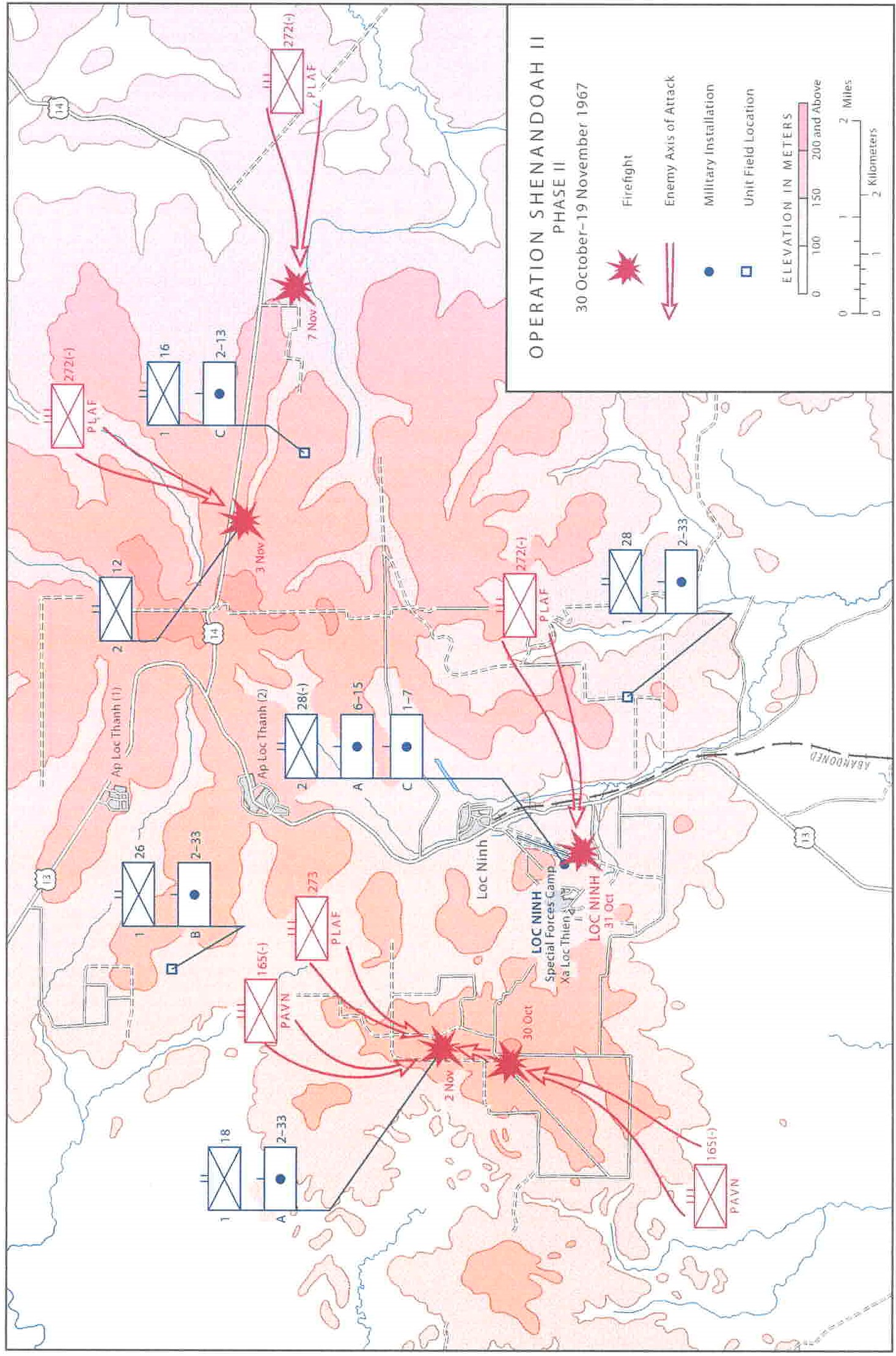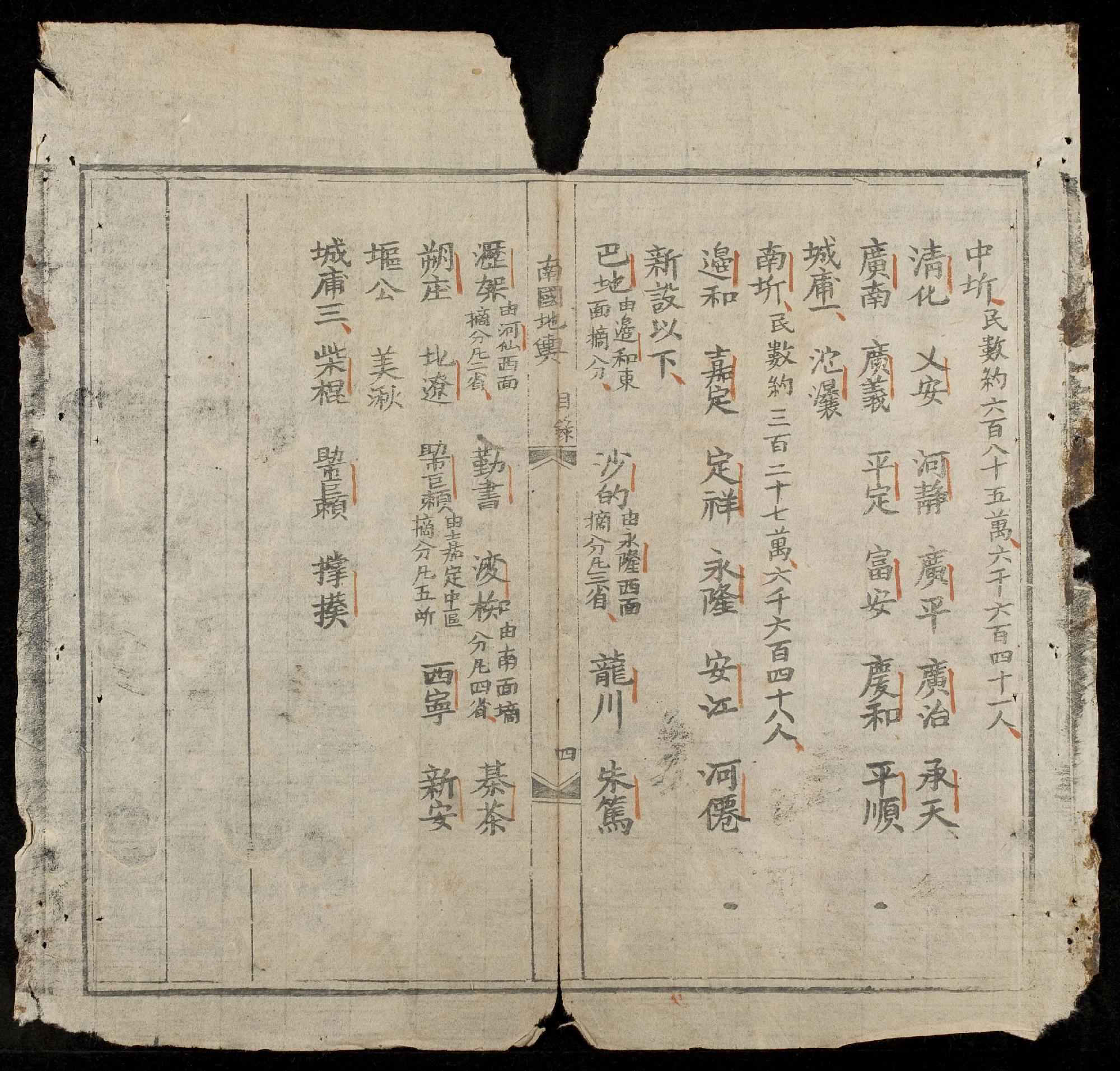|
First Battle Of Loc Ninh
The First Battle of Loc Ninh took place during the Vietnam War that occurred between 29 October and 7 November 1967, fought by the Viet Cong, Army of the Republic of Vietnam (ARVN), Civilian Irregular Defense Group and the United States Army. The battle was part of the Operation Shenandoah II campaign. This battle represented the first time that Central Office for South Vietnam (COSVN) had coordinated attacks from different divisions, and was intended as "rehearsal" to experiment with urban-fighting techniques to be used for the Tet Offensive. Operational goals of COSVN was in part, to draw US and ARVN forces away from the cities in an upsurge of activity, in preparation for the Tet Offensive the next year. Background Loc Ninh is a town located in Binh Long Province, approximately east of the Cambodian border and north of Saigon. As a part of his strategic preparations for the Tet Offensive in early 1968, General Võ Nguyên Giáp began attacking isolated allied bases i ... [...More Info...] [...Related Items...] OR: [Wikipedia] [Google] [Baidu] |
Operation Shenandoah II
Operation Shenandoah II was a security operation conducted during the Vietnam War by the U.S. 1st Infantry Division to secure and repair Highway 13, South Vietnam from 29 September to 19 November 1967. Background For the 1967–1968 dry season, II Field Force, Vietnam planned to mount a large-scale offensive to cut the three main infiltration routes into III Corps from Cambodia. In order to build up the necessary forces near the Cambodian border and sustain their operations Highway 13 needed to be opened and secured. Meanwhile, Central Office for South Vietnam (COSVN) commander General Trần Văn Trà pursued a strategy of attrition using his People's Army of Vietnam (PAVN) and Viet Cong (VC) forces to attack U.S. military units to cause as many casualties as possible hoping that the Americans would conclude that the war was too costly and withdraw from South Vietnam. Trà's deputy, General Hoàng Văn Thái planned to use the experienced VC 9th Division commanded by Senio ... [...More Info...] [...Related Items...] OR: [Wikipedia] [Google] [Baidu] |
United States Army
The United States Army (USA) is the primary Land warfare, land service branch of the United States Department of Defense. It is designated as the Army of the United States in the United States Constitution.Article II, section 2, clause 1 of the United States Constitution (1789).See alsTitle 10, Subtitle B, Chapter 301, Section 3001 It operates under the authority, direction, and control of the United States Secretary of Defense, United States secretary of defense. It is one of the six armed forces and one of the eight uniformed services of the United States. The Army is the most senior branch in order of precedence amongst the armed services. It has its roots in the Continental Army, formed on 14 June 1775 to fight against the British for independence during the American Revolutionary War (1775–1783). After the Revolutionary War, the Congress of the Confederation created the United States Army on 3 June 1784 to replace the disbanded Continental Army.Library of CongressJournals ... [...More Info...] [...Related Items...] OR: [Wikipedia] [Google] [Baidu] |
Bell UH-1 Iroquois
The Bell UH-1 Iroquois (nicknamed "Huey") is a utility military helicopter designed and produced by the American aerospace company Bell Helicopter. It is the first member of the prolific Huey family, as well as the first turbine-powered helicopter in service with the United States military. Development of the Iroquois started in the early 1950s, a major impetus being a requirement issued by the United States Army for a new medical evacuation and utility helicopter. The Bell 204, first flown on 20 October 1956, was warmly received, particularly for the performance of its single turboshaft engine over piston engine-powered counterparts. An initial production contract for 100 ''HU-1A''s was issued in March 1960. In response to criticisms over the rotorcraft's power, Bell quickly developed multiple models furnished with more powerful engines; in comparison to the prototype's Lycoming YT53-L-1 (LTC1B-1) engine, producing , by 1966, the Lycoming T53-L-13, capable of , was bein ... [...More Info...] [...Related Items...] OR: [Wikipedia] [Google] [Baidu] |
Battle Of Loc Ninh 29 October 1967
A battle is an occurrence of combat in warfare between opposing military units of any number or size. A war usually consists of multiple battles. In general, a battle is a military engagement that is well defined in duration, area, and force commitment. An engagement with only limited commitment between the forces and without decisive results is sometimes called a skirmish. The word "battle" can also be used infrequently to refer to an entire operational campaign, although this usage greatly diverges from its conventional or customary meaning. Generally, the word "battle" is used for such campaigns if referring to a protracted combat encounter in which either one or both of the combatants had the same methods, resources, and strategic objectives throughout the encounter. Some prominent examples of this would be the Battle of the Atlantic, Battle of Britain, and the Battle of France, all in World War II. Wars and military campaigns are guided by military strategy, whereas batt ... [...More Info...] [...Related Items...] OR: [Wikipedia] [Google] [Baidu] |
Frederick C
Frederick may refer to: People * Frederick (given name), the name Given name Nobility = Anhalt-Harzgerode = * Frederick, Prince of Anhalt-Harzgerode (1613–1670) = Austria = * Frederick I, Duke of Austria (Babenberg), Duke of Austria from 1195 to 1198 * Frederick II, Duke of Austria (1219–1246), last Duke of Austria from the Babenberg dynasty * Frederick the Fair (Frederick I of Austria (Habsburg), 1286–1330), Duke of Austria and King of the Romans = Baden = * Frederick I, Grand Duke of Baden (1826–1907), Grand Duke of Baden * Frederick II, Grand Duke of Baden (1857–1928), Grand Duke of Baden = Bohemia = * Frederick, Duke of Bohemia (died 1189), Duke of Olomouc and Bohemia = Britain = * Frederick, Prince of Wales (1707–1751), eldest son of King George II of Great Britain = Brandenburg/Prussia = * Frederick I, Elector of Brandenburg (1371–1440), also known as Frederick VI, Burgrave of Nuremberg * Frederick II, Elector of Brandenburg (1413–1470), Ma ... [...More Info...] [...Related Items...] OR: [Wikipedia] [Google] [Baidu] |
II Field Force, Vietnam
II Field Force, Vietnam was a United States Army Corps-level command during the Vietnam War. Activated on 15 March 1966, it became the largest corps command in Vietnam and one of the largest in Army history. II Field Force was assigned the lineage of the XXII Corps, a World War II corps in the European Theater of Operations. II Field Force was a component of U.S. Military Assistance Command Vietnam (MACV) and had its headquarters in Long Binh. Area of responsibility II Field Force's area of responsibility was III Corps Tactical Zone, later renamed Military Region 3, which comprised eleven provinces surrounding Saigon. This was designed to mimic the ARVN III Corps region. II Field Force controlled units participating in the 1968 Tet Offensive and the 1970 Cambodian Incursion. Units assigned At various times during the Vietnam War, II FFV controlled the following units: * 1st Infantry Division * 9th Infantry Division * 25th Infantry Division *101st Airborne Division *1st Ca ... [...More Info...] [...Related Items...] OR: [Wikipedia] [Google] [Baidu] |
South Vietnamese Popular Forces
The South Vietnamese Popular Force (, PF) (originally the Self-Defense Corps) was a part-time local militia of the Army of the Republic of Vietnam (ARVN) during the Vietnam War. The South Vietnamese Popular Force mainly protected homes and villages in South Vietnam from attacks by the Viet Cong (VC) and later the People's Army of Vietnam (PAVN). The Popular Force resembled the Local Force and village-guerrilla level component of the VC, while the Regional Force was a full-time force available for operations within a province. The Popular Force was initially very poorly-trained and equipped, but often bore the brunt of PAVN/VC attacks. PF and Regional Force units were responsible for inflicting an estimated 30% of the total PAVN/VC casualties throughout the war, and were much more capable of fulfilling ambush and small-unit movement, reconnaissance and detection roles than larger, slow-moving conventional forces. History A survey in May 1957 had revealed that there were about 50 ... [...More Info...] [...Related Items...] OR: [Wikipedia] [Google] [Baidu] |
South Vietnamese Regional Forces
The South Vietnam South Vietnam, officially the Republic of Vietnam (RVN; , VNCH), was a country in Southeast Asia that existed from 1955 to 1975. It first garnered Diplomatic recognition, international recognition in 1949 as the State of Vietnam within the ...ese Regional Forces (, lit. "Local Army"), originally the Civil Guard, were a component of Army of the Republic of Vietnam (ARVN) territorial defence forces. Recruited locally, they served as full-time province-level forces, originally raised as a militia. In 1964, the Regional Forces were integrated into the ARVN and placed under the command of the Joint General Staff. The concept of Regional Forces was to counter the Viet Cong (VC) Viet Cong and PAVN strategy, organization and structure, Local Force units, while the ARVN regular forces fought the better equipped VC Main Force units and the People's Army of Vietnam (PAVN). Local militia came to play a very effective role in the war, as the style of small-unit warf ... [...More Info...] [...Related Items...] OR: [Wikipedia] [Google] [Baidu] |
Võ Nguyên Giáp
Võ Nguyên Giáp ( vi-hantu, , ; 25 August 1911 – 4 October 2013) was a Vietnamese general, communist revolutionary and politician. Highly regarded as a military strategist, Giáp led Vietnamese communist forces to victories in wars against Japan, France, South Vietnam, the United States, and China. Giáp was the military commander of the Việt Minh and the People's Army from 1941 to 1972, minister of defense of the Democratic Republic of Vietnam (North Vietnam) and the Socialist Republic of Vietnam in 1946–1947 and from 1948 to 1980, and deputy prime minister from 1955 to 1991. He was a member of the Politburo of the Communist Party of Vietnam. Born in Quảng Bình province to an affluent peasant family, Giáp participated in anti-colonial political activity in his youth, and in 1931 joined the Communist Party of Vietnam, led by Ho Chi Minh. Giáp rose to prominence during World War II as the military leader of the Việt Minh resistance against the Japanese ... [...More Info...] [...Related Items...] OR: [Wikipedia] [Google] [Baidu] |
Saigon
Ho Chi Minh City (HCMC) ('','' TP.HCM; ), commonly known as Saigon (; ), is the most populous city in Vietnam with a population of around 14 million in 2025. The city's geography is defined by rivers and canals, of which the largest is Saigon River. As a Municipalities of Vietnam, municipality, Ho Chi Minh City consists of 16 List of urban districts of Vietnam, urban districts, five Huyện, rural districts, and one Municipal city (Vietnam), municipal city (sub-city). As the largest financial centre in Vietnam, Ho Chi Minh City has the largest gross regional domestic product out of all Vietnam provinces and municipalities, contributing around a quarter of the Economy of Vietnam, country's total GDP. Ho Chi Minh City metropolitan area, Ho Chi Minh City's metropolitan area is List of ASEAN country subdivisions by GDP, ASEAN's 5th largest economy, also the biggest outside an ASEAN country capital. The area was initially part of Cambodian states until it became part of the Vietna ... [...More Info...] [...Related Items...] OR: [Wikipedia] [Google] [Baidu] |






